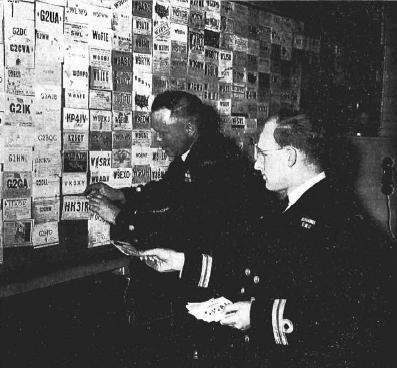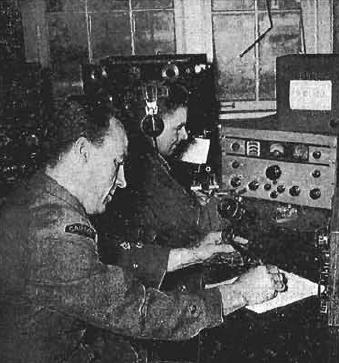 |
| QSL card of club station VE1HO. (From Crowsnest Magazine August 1950) |
From the outside, there is nothing unusual about Room 229 on the second floor of the Electrical School Building at HMCS Stadacona,but inside there sits a man talking to the world. "This is Halifax, Nova Scotia, calling. This is VE1HO in Halifax calling ... " He tunes the band ...suddenly the signal strength meter needle jumps to the right ... a strange voice comes through the loudspeaker. "VE1HO, this is George, four, Peter Mike, Mike calling, in London, England. Hearing you strength seven, readability eight. Give me a call, please ... "The conversation continues and it is not long before VE1HO, the amateur radio station of the Communication and Electrical Schools at Stadacona, has gained another new friend. During the past four years it has been making a lot of them. It's a world-wide kind of friendship. The walls of the station are nearly covered with QSL cards from radio amateurs in all parts of the globe. "Hams" in Ireland, the Virgin Islands, Japan, Italy, Florida, Sweden, New Zealand and France just to mention a few - make contact with VE1HO regurarily. And then there is a certain lady called "Margo," in Guatemala, who frequently calls up Halifax to chat with the naval "hams."
 |
| QSL card of club station VE1HO. (From Crowsnest Magazine August 1950) |
Station VE1HO was started by the former Communication School in HMC Dockyard. Its first president was CPO Holland Shepherd, who still takes a leading role in the club's activities. It was in late 1945 that the club first went on the air with a small home-made transmitter. Only the 10-metre band was used, but many valuable contacts were made. In March 1948, when the Communication School was transferred to "Stadacona," the club moved its stntion to the basement of the new establishment. Membership increased rapidly. In order to accommodate the influx, two separate stations were set up. The Electrical School began transmitting under the call signs VElRN and the Communication School retained VE1HO as its call letters. Both stations were under the supervision of Lieut. (L) Charles Williams.When war surplus equipment was placed on the market a. number of members bought themselves some and started stations in their own homes. The club's activities declined and finally VE1RN was abandoned and all transmitting was done through VE1HO. A great boost was given the club in the Fall of 1949 when, during the administration of Cdr. (L) H. G. Burchell ("L" School) and Lieut.-Cdr. J.C. O'Brien (Comschool) the station was given its own room on the second floor of the Electrical School building.
Two workable transmitters were put together out of used equipment and a schedule for daily broadcasts was begun.Due to the constant changing of personnel under training it has been difficult to maintain a strong, active membership. However, the future looks bright. The Navy has made available a new CW and phone transmitter - a 500-watt set which will operate on the 20, 40 and 80 metre bands. The mainstays of the club at present are CPO Shepherd, CPO Jim Mathews, CPO Harold Jacques, Instr. Lieut. Kenneth E. Vavasour, Lieut.Cdr (L) Robert Whyte, Cadet Tom Clahane, Ord. Sea. Marven Bushby, CPO Don McGee and PO William Murray.
 |
| One way of papering your walls is demonstrated by members of the VE1HO Amateur Radio Club. Instr. Lieut. Kenneth E. Vavasour, club president, and CPO James Mathews add a few more QSL cards to club's collection of cards from all parts of the world. (RCN photo HS-11345 via Crowsnest Magazine) |
The club does not consider itself an exclusive group. On the contrary, it is anxious to enlist new members and stimulate interest in amateur radio.Its main goal, according to Lieut. Vavasour, president of VE1HO, is "the provision of amateur radio operating facilities for all interested naval personnel. There are no dues. All that are required are a certificate of radio proficiency and a sincere interest in ham radio." CPO Jacques, the secretary treasurer of VE1HO, is willing to teach the necessary requirements for a certificate of radio proficiency to all those interested. He says, "We will soon be using new and much more elaborate equipment. If we are to operate it with maximum efficiency, we need new members. Everyone is welcome to join VE1HO - the more members we have, the better we'll like it.
 |
| CPO Holland Shepherd and O/S Marven Bushby operating VE1HO. That's an RCA AR-88 receiver in the photo. It won't be long before their CQ is answered and another station added to their already impressive list of contacts. The station was established in 1945 and was still going strong in 1950. (RCN photo HS11364 via Crowsnest Magazine) |
Update: When the Communication School moved from HMCS STADACONA to HMCS CORNWALLIS, station VE1HO moved with the school. Here is the article from Feb 1953 Crowsnest which announces the resurrection of VE1HO at Cornwallis.“An amateur radio club has been organized at HMCS Cornwallis and the naval training establishment is now on the ham bands. Commander R. M. Murdoch is president of the RCN Amateur Radio Club Cornwallis. The other officers are: First Vice-President, CPO Jack Mooney; second Vice-President, Commissioned Communications Officer J. W. Jewers, and secretary, PO D. A. Potter.
To help it on its opening day, the club received a grant of $600 from the Ship's Fund for the purchase of materials and tools to build a transmitter of approximately 350 watts output. Operating under the call letters VEIHO, the club is on the air from 2030 to 2230 on Mondays (following the weekly business meeting) and from 1930 to 2230 on Thursdays, on a frequency of 7040 kilocycles (approximately) and with an output of 150 watts on CW only. New members who have not had radio experience are given lectures on basic theory and radio principles by PO Mooney during the Monday night operating periods”.
QST Magazine June, 1952, Maritime Division reports that "VE1HO is now at Cornwallis transmitting on A1 and A3 mostly on 14-mc/s"
Back to Radio Training Facilities Sept 6/08